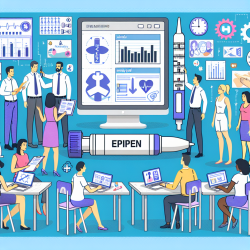Introduction
Anaphylaxis is a critical, life-threatening condition that requires immediate attention. With the rising incidence of food allergies among children, schools need to be adequately prepared to manage anaphylactic reactions. The research article "Training and administration of epinephrine auto-injectors for anaphylaxis treatment in US schools: results from the EpiPen4Schools® pilot survey" provides valuable insights into the current state of preparedness in US schools. This blog aims to help practitioners enhance their skills by implementing research outcomes or encouraging further research.
Key Findings from the EpiPen4Schools® Pilot Survey
The survey involved 6,019 schools across the US, revealing significant disparities in preparedness to manage anaphylaxis. Here are some critical findings:
- 11% of schools reported one or more anaphylactic events during the 2013-2014 school year.
- Only 36% of schools trained the school nurse and select staff in anaphylaxis recognition.
- 54% of schools allowed only the school nurse and select staff to administer epinephrine.
These findings indicate a need for broader training and more inclusive policies to enable timely and effective responses to anaphylactic events.
Improving School Preparedness
To improve outcomes for children experiencing anaphylaxis, schools should consider the following strategies:
- Expand Training: Ensure that all school staff are trained to recognize anaphylaxis symptoms and administer epinephrine. This approach can significantly increase the likelihood of timely intervention.
- Policy Changes: Advocate for policies that allow a broader range of staff to administer epinephrine. This can be crucial during field trips or extracurricular activities when the school nurse may not be present.
- Stock Epinephrine: Schools should maintain a stock of epinephrine auto-injectors, especially given that 22% of anaphylactic events occur in individuals with no known allergies.
Encouraging Further Research
While the EpiPen4Schools® survey provides a comprehensive overview, further research is needed to address gaps and barriers in anaphylaxis management. Practitioners can contribute by:
- Conducting studies on the effectiveness of different training programs.
- Exploring regional disparities in preparedness and identifying underlying causes.
- Investigating the impact of socioeconomic factors on the availability of epinephrine in schools.
Conclusion
Ensuring that schools are well-prepared to manage anaphylaxis is a public health priority. By expanding training, implementing inclusive policies, and stocking necessary medication, schools can significantly improve outcomes for children. Practitioners are encouraged to utilize these research findings to enhance their skills and advocate for necessary changes.
To read the original research paper, please follow this link: Training and administration of epinephrine auto-injectors for anaphylaxis treatment in US schools: results from the EpiPen4Schools® pilot survey.










